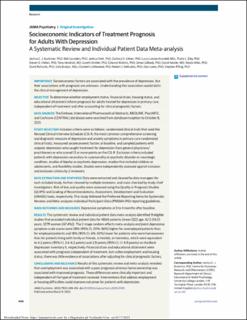| dc.description.abstract | Importance Socioeconomic factors are associated with the prevalence of depression, but their associations with prognosis are unknown. Understanding this association would aid in the clinical management of depression.
Objective To determine whether employment status, financial strain, housing status, and educational attainment inform prognosis for adults treated for depression in primary care, independent of treatment and after accounting for clinical prognostic factors.
Data Sources The Embase, International Pharmaceutical Abstracts, MEDLINE, PsycINFO, and Cochrane (CENTRAL) databases were searched from database inception to October 8, 2021.
Study Selection Inclusion criteria were as follows: randomized clinical trials that used the Revised Clinical Interview Schedule (CIS-R; the most common comprehensive screening and diagnostic measure of depressive and anxiety symptoms in primary care randomized clinical trials), measured socioeconomic factors at baseline, and sampled patients with unipolar depression who sought treatment for depression from general physicians/practitioners or who scored 12 or more points on the CIS-R. Exclusion criteria included patients with depression secondary to a personality or psychotic disorder or neurologic condition, studies of bipolar or psychotic depression, studies that included children or adolescents, and feasibility studies. Studies were independently assessed against inclusion and exclusion criteria by 2 reviewers.
Data Extraction and Synthesis Data were extracted and cleaned by data managers for each included study, further cleaned by multiple reviewers, and cross-checked by study chief investigators. Risk of bias and quality were assessed using the Quality in Prognosis Studies (QUIPS) and Grading of Recommendations, Assessment, Development and Evaluation (GRADE) tools, respectively. This study followed the Preferred Reporting Items for Systematic Reviews and Meta-analyses–Individual Participant Data (PRISMA-IPD) reporting guidelines.
Main Outcomes and Measures Depressive symptoms at 3 to 4 months after baseline.
Results This systematic review and individual patient data meta-analysis identified 9 eligible studies that provided individual patient data for 4864 patients (mean [SD] age, 42.5 (14.0) years; 3279 women [67.4%]). The 2-stage random-effects meta-analysis end point depressive symptom scale scores were 28% (95% CI, 20%-36%) higher for unemployed patients than for employed patients and 18% (95% CI, 6%-30%) lower for patients who were homeowners than for patients living with family or friends, in hostels, or homeless, which were equivalent to 4.2 points (95% CI, 3.6-6.2 points) and 2.9 points (95% CI, 1.1-4.9 points) on the Beck Depression Inventory II, respectively. Financial strain and educational attainment were associated with prognosis independent of treatment, but unlike employment and housing status, there was little evidence of associations after adjusting for clinical prognostic factors.
Conclusions and Relevance Results of this systematic review and meta-analysis revealed that unemployment was associated with a poor prognosis whereas home ownership was associated with improved prognosis. These differences were clinically important and independent of the type of treatment received. Interventions that address employment or housing difficulties could improve outcomes for patients with depression. | en_US |

